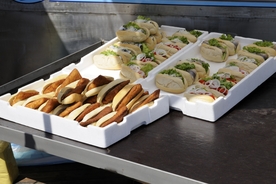If you're anything like me, the following scenario plays out at least once a month in your kitchen.
Fresh from a trip to the grocery store, you go to make space in your fridge, only to discover that half of the food you own has now gone varying degrees of mouldy. Cheese, pasta, half a loaf of bread... it's another sum of money down the drain, and you know that you'll be there in another month, shaking your head at exactly the same thing.
In order to keep that from happening, there's something you could do. You could organise your shopping habits, making sure that no drop or crumb is wasted, saving yourself tons of money in the process, but that... sounds like a lot of effort. Why not just buy foods that'll never go bad instead?
1. HoneyBack in 2015, archaeologists found 3,000-year-old honey while excavating in Egypt, and they say that it was perfectly edible. It makes a lot of sense; with a high sugar content but low levels of moisture, it's really hard for bacteria to grow on honey, so it stays fresh for a really long time. Sometimes, honey will crystallise if allowed to take in moisture, but that can be rectified by simply warming the honey.
2. Dried pulsesAs with honey, the drying process allows pulses to keep their sugar content while also getting rid of their moisture, making it hard for anything untoward to grow on them. The drying process also puts he enzymes that'd otherwise cause the pulse to break down into suspended animation. Kept properly in an airtight container, dried pulses can last for years.
3. Soy sauceProvided you don't make too many stir-fries, you should be okay with your bottle of soy sauce for at least three years. Soy sauce's high salt content (plus the fact that it's fermented) mean that as long as it's unopened, you should have soy sauce for a long while yet. Once you open it, though, all bets are off: it mainly depends on the type of soy sauce, and the temperature it's stored at.
4. VinegarVinegar (or acetic acid, for all of you chemistry nerds out there) is technically just spoiled wine or cider, so there's an argument that it's already gone bad. But let's not nitpick: with its high acidity (due to actually being a diluted acid), no bacteria can grow in it, so you should be okay for quite a while yet.
5. White riceWhile reheated rice can sometimes make you super sick, white rice that's uncooked can last you a very long time, provided you store it in the right places. White rice has been known to last for as many as 30 years, but studies show that unless you store it in an oxygen-free environment at about three degrees Celsius, you're cutting into the shelf life of your grains. Brown rice, though considered healthier, doesn't last as long thanks to its fibrous bran (which can turn rancid).
6. Dark chocolateThere's quite a bit of debate as to whether chocolate can actually go bad. Although adding milk to the stuff may lower its shelf life, dark chocolate will last for around two years, provided you keep it at a constant temperature.
7. Sugar and saltIf you've been paying attention, you'll notice that most of the foods on this list are high in either sugar or salt. That's because both sugar and salt are really good at drawing water out, so bacteria find it impossible to grow there. That's why so many processed meats like ham or chorizo are loaded with salt, and why your favourite jams are packed with sugar. Unless you add additives (eg. adding iodine to salt), in which case you're looking at a shelf life of about five years. Not too shabby.
Well, there we have it folks. Take note of the components of a long-lasting food item, and remember them well. Sugar and salt - good; microbes - bad. Six words instead of nearly 700. Oops.

